The Aesthete's Fleet
I answered a kind invitation from a fellow Alfa club member to drive his early Alfetta saloon. It is an intriguing car and keeps company with a Subaru SVX. Built in South Africa in 1976 and badged as an Executive, it was fitted with the same two litre engine as the GTV. Unsurprisingly, it drove with similar verve and handling characteristics. It did not have the vibrating propellor shaft that makes you feel like you are driving a large marital aid. Wonder Boy is to investigate and a report will be issued when the problem is properly diagnosed. Needless to say, the web is full of stuff and nonsense on the issue of Alfetta propellor shafts with remedies including fixing hose clamps to the recalcitrant rotating items. I doubt that even the Arese engineers would stoop to that.
1954 Austin A40 Countryman. The Aesthete has a weakness for old British light commercials so this Countryman would find a place in his large open span shed that is becoming necessary to house his sprawling collection. Until that happy dream is realised someone else will have to rise to the challenge of sorting this one out. It should be painted drab green with some tasteful sign writing tendering whatever services the owner is prepared to offer.
For: Not for hurrying about in.
Against: Imagine the din at open road speed.
Investment potential: 4/10 as the start price is fair for something this rare and charming.
1953 Sunbeam Talbot 90 Mk 2A DHC. The cosy cabin of the Sunbeam Talbot saloon was determined by the roof pressing of the old Sunbeam Talbot 10 so cutting the whole thing off produced a handsome and roomy convertible. A larger rear window aperture appears in place of the letter slot originally fitted and the awkward shape suggests a bit of creative bodging has gone on. The fruity colour is also possibly not pukkah but I am beginning to sound like I do not like this car when I very much do.
For: Not much around to compete with this.
Against: Only snobbish conceits about the grand names of Sunbeam and Talbot being applied to tarted up Humbers.
Investment potential: 2/10. 25K is already quite a bit for a ST90 so we will wait and see.
1955 Buckler Mk 6. Before Colin Chapman rewrote the clubman racer book with the Lotus Seven, the field was open for a host of others to artfully rearrange piles of used Ford parts into cheap and cheerful competition cars. Buckler was a Reading based maker whose clever space frame chassis allowed them to stay ahead of the cruder competition. This example was built under licence in New Zealand and has a storied past having been destroyed and rebuilt into its present form. The pictures on the listing tell all.
For: It will feel quick even on 40 horse power.
Against: It is no Lotus.
Investment potential: 2/10 although the asking price does not seem greedy.
1997 TVR Cerberra: TVR went all out in the 1990s and commissioned its own engines off the sometime frock maker and Formula One engine guru Al Melling. Thus the TVR carried its mad genetic material into the world of very high performance cars where the resultant Speed Eight had to be governed to 185 MPH. Some versions had an unmarked button on the dash that switched the engine mapping so that the driver could leave the earth's gravitational pull. God knows what they made of all this in Japan but I doubt if this car was used on the daily commute.
For: Nothing remotely effete about this Blackpool yob carrier.
Against: The horror stories about Cerberras just seem to add fuel to the fire.
Investment potential: At 60K you might wonder but the horsepower to dollar ratio is probably in your favour.
1994 Jaguar XJR Supercharged. Or for around one sixth of the the price of a TVR you could go almost as fast but reliably in this Jaguar that features a supercharged version of the silky and sonorous six cylinder engine. Jaguar was recovering after the anodyne replacement for the much admired XJ6 failed to impress anyone, leaving discussion focused on its automatic gear selector dubbed the Randle handle, surely only a little less interesting than a rubber grommet.
For: Grace, space and pace, redux.
Against: Bound to appreciate, says the vendor.
Investment potential. 1/10. Well he would say that, wouldn't he? Oh, and vale Christine Keeler, the party girl who brought down the British government as that was her line.
On some faraway beach
1965 Nissan Silvia CSP311. Produced in tiny numbers and hand built, the first Datsun 1500 coupes were designed by Count Albrecht Goertz, a German/American who worked in Raymond Loewy's New York studio before setting out on his own. His main contribution in Japan was showing the stylists how to produce full sized clay models and this very pretty coupe was the outcome.
For: Oh come on. Its gorgeous.
Against: Not much that I can see.
Investment potential: 4/10. Look at the prices of other small run Japanese sports cars for comparative purposes.




























